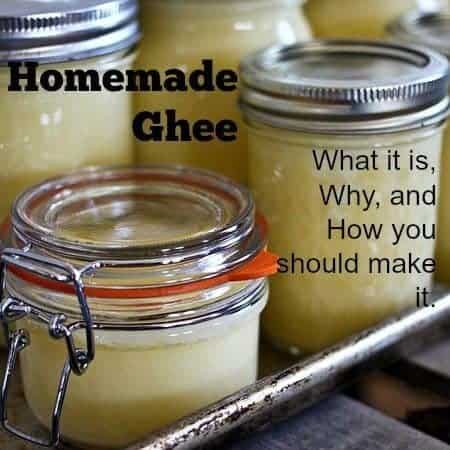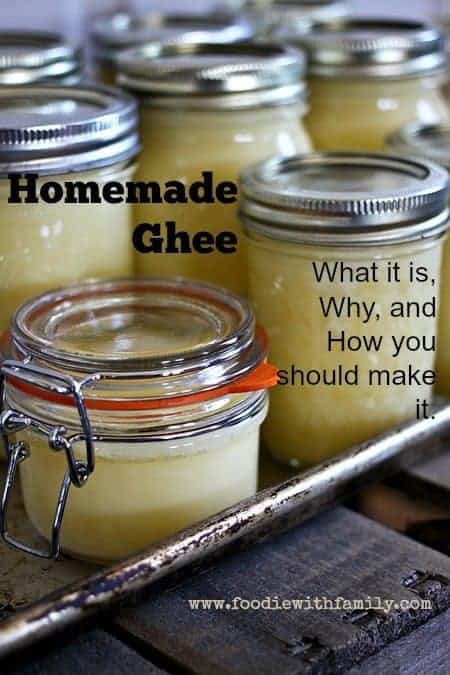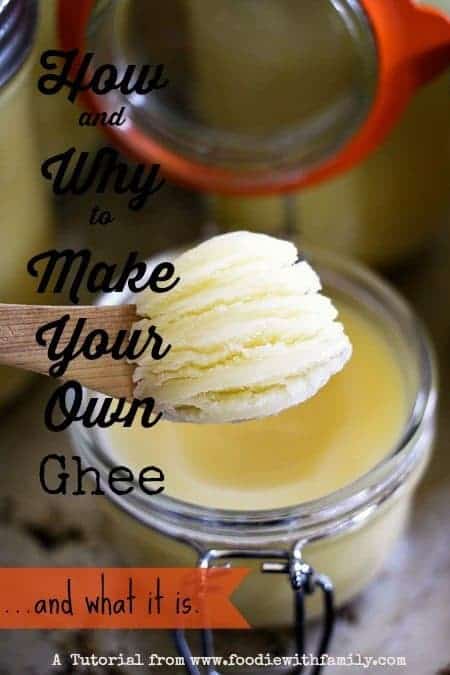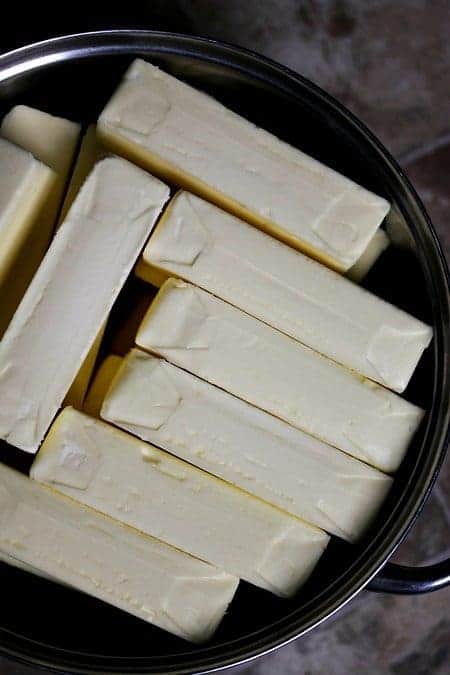Today, I’m sharing a tutorial with you on how to make one of my favourite all-purpose ingredients: Ghee. Some of you are nodding happily and some of you are saying “jee? gee? whuh?” The simplest explanation of what it is could be summed up as “Heaven in a jar”.
What is Ghee?
Ghee, pronounced “gee” with a hard ‘g’- is a form of clarified butter made by melting down butter and cooking it long enough to evaporate the water from it, separate, and then toast the milk solids that naturally occur in butter, leaving behind only pure, golden butterfat. The long, slow cooking process results in a concentrated nutty, toasted butter flavour.
Why Should I Make Ghee?
There is a whole host of reasons why Ghee should always be handy in your pantry/refrigerator/freezer. Among them…
First and foremost, TASTE! Ghee isn’t just for Indian food. It makes the best flavoured fat for frying or scrambling eggs, searing a steak or other cut of meat, sautéeing vegetables or seafood, spreading over freshly baked bread to keep the crust soft, in oatmeal, and just about any other place you’d value a nutty, rich, deep butter flavour.
Having ghee available is like having a handy source of browned butter to add to anything you want. In my estimation, 2/3 of the jobs for which I’d use butter can be done with ghee to great effect.
The clarifying process raises the smoke point of butter from a paltry 250°F to an impressive 485°F. That’s a higher smoke point than peanut oil, canola oil, or vegetable oil. This is why you CAN sear a steak or other meat in it. Regular butter can’t do this without scorching.
It extends the life of butter. Making ghee when you can find large quantities of butter on sale isn’t just a flavour booster.
Regular butter is considered ‘good’ for 1 month after the sell-by date when stored in the refrigerator, or 6 to 9 months after the sell-by date in the freezer. (Source) Ghee can be stored, unopened, in a cool, dark, not-necessarily-refrigerated place for 9 months.
Once opened, a jar can be kept on your counter top for 3 months. Beyond that, the open jar can be stored in the refrigerator for up to 1 year. (Source) A jar of ghee in the freezer at 0°F can be kept indefinitely.
Further down the list for me, but still important is the fact that Ghee is a crucial flavour component to many international cuisines including Indian, Syrian, Lebanese, Persian, Arabic, Pakistani, Georgian, and many others. Even German and French cuisine make use of a version of ghee (Butterschmaltz and Beurre Noisette, respectively.)
It can make butter friendly for those dealing with casein and lactose intolerance. (Source) This does not mean that someone with a true dairy ALLERGY can consume it, but the process of making ghee removes the lactose and casein from the butterfat making it more digestible for someone who experiences unpleasant side effects from eating butter or other dairy.
If you are an adherent to a paleo, GAPS, or real food lifestyle, this is not only acceptable, but is highly recommended as a nutritious dietary fat.
How to Make Ghee at Home:
In short, put a bunch of unsalted butter in a pan on the lowest heat setting you can possibly manage on your stove top then let it go for hours. To expound, occasionally you give it a stir.
If (in the words of Liz of The Lemon Bowl’s Aunt Paula) your butter is smiling at you, you’re doing it right. In other words, you’re not BOILING it, you’re really PERCOLATING it.
It really is that simple. I’d advise you against leaving the house while it’s done, but other than that, you’re really not tethered to it.
When the butterfat has separated out, you skim any foam from the top. Please put that on some toast. You’ll think you’ve died and gone to heaven.
Line a fine-mesh sieve with a flour sack towel or muslin or butter cheesecloth (or a double thickness or muslin or butter cheesecloth for a colander), place it over a heat-safe pitcher or bowl and ladle the ghee into it. This removes any lingering impurities making it keep longer in the jars.
One more important word about Liz’s Aunt Paula! Her post is what inspired me to move from my former small-batch mindset on ghee to thinking big.
Why a large batch had never occurred to me, I couldn’t say, but it makes sense practically to use her method. If you’re going to be rendering down butter for hours on end, you might as well get as much yield out of the energy -whether it be propane, natural gas, or electric- spent on the process as possible, right? Thank you, Aunt Paula!
How to Make Ghee from Butter
The first rule is to start with unsalted butter. There are two main reasons to use unsalted butter to make your ghee.
One: Unsalted butter is generally fresher. Two: Salt concentrates as the ghee is made and can yield an inedibly salty final product.
Ghee Recipe Cook’s Notes:
As mentioned, use only fresh, unsalted butter. Because the flavour concentrates as it cooks, you want a good product at the beginning.
It is important to use a large, heavy-bottomed stock pot or soup pan for making the ghee recipe. The heavy bottom helps keep the temperature even and helps prevent the milk solids from scorching as they fall to the bottom.
You don’t need to stir constantly, but you should stir well occasionally, scraping the bottom of the pan to keep the milk solids from completely adhering to the bottom of the pan.
This is because you don’t want it to scorch. They will settle there, but if you keep them from cementing there, your overall ghee will taste better.
Count on the volume of your butter being reduced by at least 25% overall. For instance, if you begin with 10 pounds of butter (which is the equivalent of 20 cups), you can assume you will end up with 15 cups or so, or possibly less depending on the beginning moisture content of your butter. This is because you’re cooking the water content out of the fat.
You’ll know the ghee is done when it is clear, deep golden butter fat, smells nutty, and has a layer of toasted milk solids at the bottom of the pan. You may find your ghee has a layer of foam floating at the top.
This is fine. It will all be removed when you strain it.
Can I Store Ghee at Room Temperature?
A word on storage: Both Liz’s Aunt Paula and many other resources recommend storing the finished, jarred, cooled ghee in a cool, dark room for long term storage. If you choose to do this, I highly recommend that you sterilize your jars (CLICK HERE to learn how to do that.) before decanting the ghee into them.
I have a basement that never rises above 56°F in temperature even in the dog days of summer. Even so, I’m not sure I’m comfortable with that. I store my ghee in the refrigerator or freezer.
If you’re in the south or somewhere particularly humid, you will definitely wish to choose the refrigerator or freezer for long term storage. Be aware that most food preservation authorities recommend the freezer for long term storage, but make your own informed choice.
Now, I do believe I’ve covered it all. Let’s make some ghee so we can all say, “Ghee, my kitchen smells terrific!”
How to Make Ghee
Unwrap and add all of the butter to a large, heavy-bottomed stockpot. Place the stockpot over the lowest heat you can manage on your cooktop.
If you have a low-powered simmer burner, it is ideal for this job. Melt down the butter and let it cook for 4-6 hours, stirring every so often, until there is a layer of deep, golden, clear, pure butter fat with toasted solids at the bottom of the pan and possibly some foam floating on top.
Do not BOIL the butter! The low heat should keep it steadily percolating at an extremely low simmer, but not boiling.
Line a fine-mesh sieve with a clean piece of muslin or flour-sack towel. If you don’t have a fine-mesh sieve, you can line a colander with a double thickness of muslin or a flour-sack towel.
Position this over a heat-proof pitcher or large bowl. Ladle the butter into the lined sieve or colander. When it has all strained, pour it into the jars to within 1/2-inch of the top. Wipe the rims, fix lids in place and let cool completely before labeling and storing.

Homemade Ghee: How and Why You Should Make It, and What It Is
Rate RecipeIngredients
- 4 to 10 pounds of butter
- sterilized jars with tight fitting lids preferably canning jars with new 2 piece lids
- 1 large heavy-bottomed stockpot
Instructions
- Unwrap and add all of the butter to a large, heavy-bottomed stockpot. Place the stockpot over the lowest heat you can manage on your cooktop. If you have a low-powered simmer burner, it is ideal for this job. Melt down the butter and let it cook for 4-6 hours, stirring every so often, until there is a layer of deep, golden, clear, pure butter fat with toasted solids at the bottom of the pan and possibly some foam floating on top. Do not BOIL the butter! The low heat should keep it steadily percolating at an extremely low simmer, but not boiling.
- Line a fine-mesh sieve with a clean piece of muslin or flour-sack towel. If you don't have a fine-mesh sieve, you can line a colander with a double thickness of muslin or a flour-sack towel. Position this over a heat-proof pitcher or large bowl. Ladle the butter into the lined sieve or colander. When it has all strained, pour it into the jars to within 1/2-inch of the top. Wipe the rims, fix lids in place and let cool completely before labeling and storing.
Nutrition
Nutritional information is an estimate and provided to you as a courtesy. You should calculate the nutritional information with the actual ingredients used in your recipe using your preferred nutrition calculator.
did you make this recipe?
Make sure to tag @foodiewithfam on Instagram and #hashtag it #foodiewithfamily so I can check it out!






Reader's Thoughts...
Jeff @ Cheese-burger.net says
At last I’ll be getting around to making my own ghee.
Rebecca says
Excellent! Enjoy it, Jeff!
Joelen says
What a fantastic idea to make in a large batch! I’m going to need to do this!!
Rebecca says
Isn’t Liz’s Aunt Paula genius?
Tieghan says
I have to try this!! I have always wonder about making gee, so I am so excited!
Rebecca says
😀 WOOT!
Maria | Pink Patisserie says
Love this tutorial and I love ghee! No need to spend the extra for it now!
Rebecca says
It really IS expensive in the stores, isn’ it?
Kim Beaulieu says
Um, you are a genius.
ps. when can I move in? Anyone who enjoys playing with butter as much as me has to be my soul foodie mate.
Rebecca says
Come now. Bring chocolate. 😀
Nancy Mock says
Thanks for this really informative post! I have never tried ghee before, but now I am really intrigued. So many cool reasons to have it on hand and it sounds so simple to make. Do you have an estimation of how much ghee I would get from a pound of butter?
Rebecca says
Hey Nancy- you can expect to lose about 25% of the overall volume (I mentioned that in the post.) You would probably have 3/4 of a cup or less when all was said and done.
Nancy Mock says
Sorry!! I see now where I missed that. Thank you for letting me know.
Rachel Cooks says
I just learned so much! What a helpful post!
Very important question: How is it on popcorn?! 😉
Rebecca says
CRUCIAL POINT: how could I have forgotten? It’s AWESOME on popcorn!
Diana Davidson says
I made Ghee today and just realized that I put the lids on while lids and jars and ghee was still hot. Won’t this cause condensation to occur? Oh dear…that will make it spoil right? :/
Thank you,
Diana
Liz @ The Lemon Bowl says
This is so fabulous!!! I can’t wait to share your post with my Aunt Paula!! <3 xoxoxo
Carly says
I wonder if you could do this with a slow cooker??
Sheila Martel says
Yes stove top for those of us who don’t have one. Work either way
Christiane ~ Taking On Magazines says
Good grief, girl! You were so convincing, I’m ready to head to the store and buy 10 pounds of butter, price be darned. I love ever reason you gave for using ghee over butter. Many thanks for the tutorial.
foodwanderings says
I have never made homemade ghee. I commend you for your patience. Even when I slightly try to clarify butter I get so frustrated. This will be perfect with the Indian flatbreads I just posted.
Marlee says
I’m intrigued by this! But can you use it for cooking – like in place of browned butter for cookies or is it more of a topping or searing agent?
Paula-bell'alimento says
Ghee rocks the house!
Rebecca says
..AND the Casbah! 😀
Caroline @ chocolate & carrots says
How cool! Thank you for teaching me something new today! 😀
Rebecca says
Thank YOU!
Angie | Big Bear's Wife says
I saw this on your Facebook and felt kinda silly because I had no idea as to what it was (other than butter) haha. But now I’m really interested in it! I may just have to make some ghee for myself!
Rebecca says
Oh goody, Angie! I hope you love it as much as we do! (But I promise, if you love butter you’ll ADORE this!)
Nancy P.@thebittersideofsweet says
I admit I had no idea what this was! It is a great tutorial and I learned something new today!
Rebecca says
Oh hooray! I’m so glad you got something good from it! Now you have to try it. Trust me… it’s DELICIOUS!
Amy @Very Culinary says
This is an awesome post for people who aren’t familiar with it… I have friends who always thought ghee was some sort of Asian sauce. O.o. Oh, bring on the butter!! *claps hands*
Rebecca says
HA! Yeah. And there are a lot of folks who know what it is that didn’t know WHY it was awesome or how they could use in dishes other than just Indian ones!
Katrina @ In Katrina's Kitchen says
All that butter. Swoon.
Rebecca says
I know. The kitchen is a happy place to be when ghee is being made!
Sherri Jo says
I love ghee and use it quite often 🙂 Love how you explained it for the masses who might not know about this wonder!
Rebecca says
Thanks, Sherri Jo! It IS wonderful isn’t it?
Sherrie | With Food + Love says
I’ve always wanted to learn how to make ghee; this post is amazing. I’m pinning
+ sharing for sure!
XO SHERRIE
Rebecca says
You’re very welcome, Sherrie! I hope you enjoy the process of making it as much as you do the eating of it! 😀
Prashanti A says
Hey Rebecca,
You don’t need to keep cooking the butter for 4 to 6hours. That is such a colossal waste of energy. 🙂
I just made ghee today from about 780gms of fresh home made butter. It took me just about 30mins to make the ghee.
Put it on slightly higher heat initially to melt all the butter and when it starts bubbling lower the heat and remove all the foam from the top. The ghee gets made a lot faster.
I got about 600+gms of ghee from my butter. I had washed the butter with cold water till the water ran clear to remove the milk, which also hastens the cooking process.
🙂
roger spotswood says
Cool!! Will try this. Always looking for something to save time in particular 3.5 hours.
Alan Edwards says
This is correct recipe for ghee. The fast version is clarified butter.
Rebecca says
Thanks for clarifying that, Alan. 🙂
Gail Rupprecht says
How do you wash butter?
Marge says
Please tell me how you wash the butter!!!!
Marie says
Washing the butter is something that is only done if you are making the butter from scratch [from cream]. It washes out any remnants of milk….
Diana Davidson says
I made Ghee today and just realized that I put the lids on while lids and jars and ghee was still hot. Won’t this cause condensation to occur? Oh dear…that will make it spoil right? :/
Thank you,
Diana
Rebecca says
Hi Diana- I’d just stash those jars right into the refrigerator and I think you’ll be okay. As long as you bubbled the water out of there sufficiently, you should be in good shape, but I’d still refrigerate it for good measure.